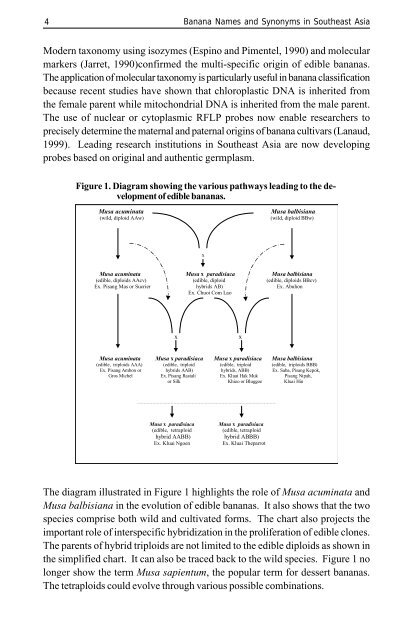Banana cultivar names and synonyms in Southeast Asia - Bioversity ...
Banana cultivar names and synonyms in Southeast Asia - Bioversity ...
Banana cultivar names and synonyms in Southeast Asia - Bioversity ...
Create successful ePaper yourself
Turn your PDF publications into a flip-book with our unique Google optimized e-Paper software.
4<br />
<strong>Banana</strong> Names <strong>and</strong> Synonyms <strong>in</strong> <strong>Southeast</strong> <strong>Asia</strong><br />
Modern taxonomy us<strong>in</strong>g isozymes (Esp<strong>in</strong>o <strong>and</strong> Pimentel, 1990) <strong>and</strong> molecular<br />
markers (Jarret, 1990)confirmed the multi-specific orig<strong>in</strong> of edible bananas.<br />
The application of molecular taxonomy is particularly useful <strong>in</strong> banana classification<br />
because recent studies have shown that chloroplastic DNA is <strong>in</strong>herited from<br />
the female parent while mitochondrial DNA is <strong>in</strong>herited from the male parent.<br />
The use of nuclear or cytoplasmic RFLP probes now enable researchers to<br />
precisely determ<strong>in</strong>e the maternal <strong>and</strong> paternal orig<strong>in</strong>s of banana <strong>cultivar</strong>s (Lanaud,<br />
1999). Lead<strong>in</strong>g research <strong>in</strong>stitutions <strong>in</strong> <strong>Southeast</strong> <strong>Asia</strong> are now develop<strong>in</strong>g<br />
probes based on orig<strong>in</strong>al <strong>and</strong> authentic germplasm.<br />
Figure 1. Diagram show<strong>in</strong>g the various pathways lead<strong>in</strong>g to the development<br />
of edible bananas.<br />
Musa acum<strong>in</strong>ata Musa balbisiana<br />
(wild, diploid AAw) (wild, diploid BBw)<br />
x<br />
Musa acum<strong>in</strong>ata Musa x paradisiaca Musa balbisiana<br />
(edible, diploids AAcv) (edible, diploid (edible, diploids BBcv)<br />
Ex. Pisang Mas or Sucrier hybrids AB) Ex. Abuhon<br />
Ex. Chuoi Com Lao<br />
x x<br />
Musa acum<strong>in</strong>ata Musa x paradisiaca Musa x paradisiaca Musa balbisiana<br />
(edible, triploids AAA) (edible, triploid (edible, triploid (edible, triploids BBB)<br />
Ex. Pisang Ambon or hybrids AAB) hybrids, ABB) Ex. Saba, Pisang Kepok,<br />
Gros Michel Ex. Pisang Rastali Ex. Kluai Hak Muk Pisang Nipah,<br />
or Silk Khieo or Bluggoe Kluai H<strong>in</strong><br />
Musa x paradisiaca Musa x paradisiaca<br />
(edible, tetraploid (edible, tetraploid<br />
hybrid AABB) hybrid ABBB)<br />
Ex. Kluai Ngoen Ex. Kluai Theparrot<br />
The diagram illustrated <strong>in</strong> Figure 1 highlights the role of Musa acum<strong>in</strong>ata <strong>and</strong><br />
Musa balbisiana <strong>in</strong> the evolution of edible bananas. It also shows that the two<br />
species comprise both wild <strong>and</strong> cultivated forms. The chart also projects the<br />
important role of <strong>in</strong>terspecific hybridization <strong>in</strong> the proliferation of edible clones.<br />
The parents of hybrid triploids are not limited to the edible diploids as shown <strong>in</strong><br />
the simplified chart. It can also be traced back to the wild species. Figure 1 no<br />
longer show the term Musa sapientum, the popular term for dessert bananas.<br />
The tetraploids could evolve through various possible comb<strong>in</strong>ations.

















